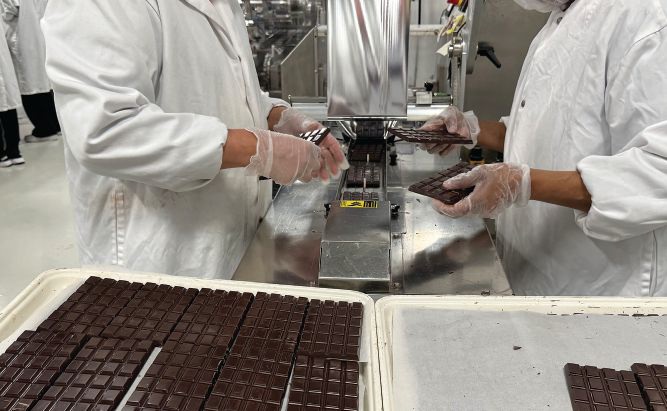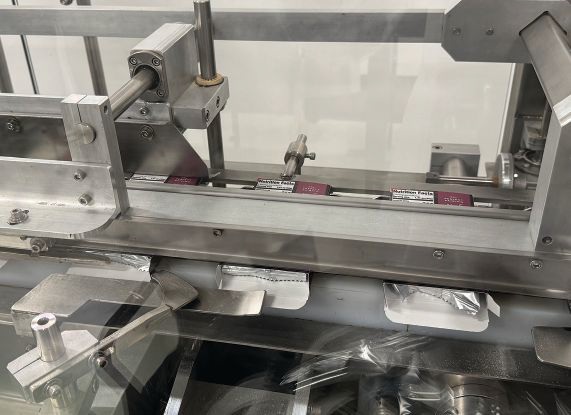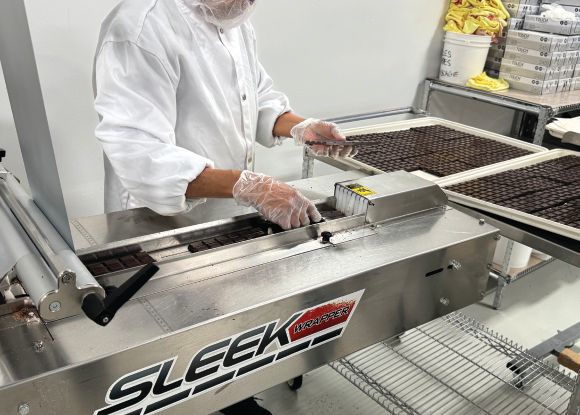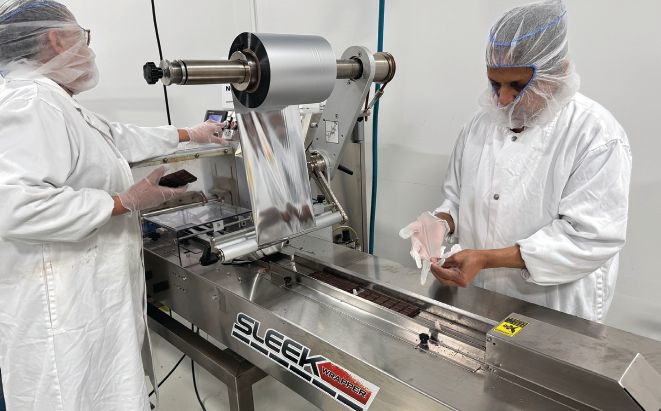For the past 40 years, Galerie au Chocolat in Montreal has been creating premium chocolates and confections for the North American market. Originally started up in 1985, the company focuses on producing only premium chocolates and confections.
Under the leadership of Noah Pinsky, president of Galerie au Chocolat, the company has grown dramatically both domestically and internationally, exporting to both the U.S. and Mexico.
Interestingly, Pinsky didn’t have any experience in the industry when he first bought the company 14 years ago. At the time, was working as a vice-president in commercial finance at the Royal Bank of Canada.
But instead of moving to Toronto to continue building his career with the bank, he and his wife decided to stay in Montreal—the city they where they were both born and raised—and to try something different.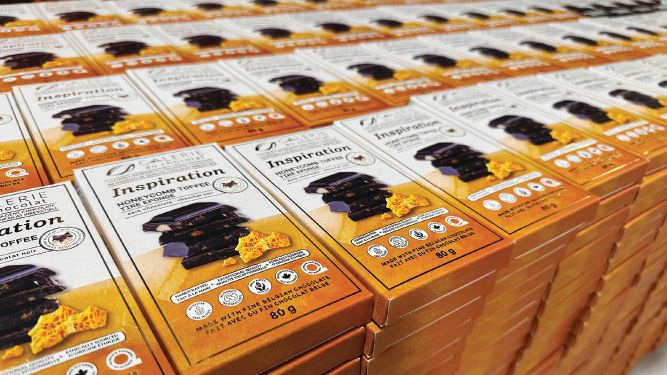
“I had worked with entrepreneurs for many years, running a team of account managers that were financing their businesses,” he recalls. “So I figured I would buy a business.”
Pinsky says he wanted to enter the food and beverage sector because he has a passion for fine foods, and also because food-related businesses are always in demand.
“Food businesses have tight margins and are very competitive, but people always have to eat,” he explains. “And so I started looking specifically for a food business.”
Through a friend of a friend, Pinsky was introduced to the former owner of Galerie au Chocolat. While the business was not for sale at the time, Pinsky and the former owner started having conversations.
“We talked for a year,” Pinsky relates. “The business was too big for me, to be quite honest, but when I found out the numbers a year down the road, I was emotionally and physically invested to make it happen.
“Because I was a banker, I knew how to get the debt tools necessary for it, and almost a year-and-a-half after the process started, I acquired Galerie au Chocolat.”
While reviewing the business for potential purchase, Pinsky identified several opportunities for enhancing the company’s production efficiencies.
“I saw an opportunity to modernize operations, invest in automation and expand the brand’s reach,” he says, “while preserving the artisanal production of their products.”
Under Pinsky’s leadership, the company expanded its operations with a 60,000-square-foot facility in Montreal, and eventually added a second 30,000-square-foot production plant in Vancouver to support the company’s growth, increase production capacity, and pursue new co-packing opportunities.
While both operations run year-round, it is very much a seasonal business, according to Pinsky, with weeks leading up to Christmas, Valentine’s Day, Easter and Mother’s Day being the busy period.
During that time, the company typically employs upwards of 120 people at its Montreal facility, lowering its staff level to about 70 people during the slower months. For its part, the Vancouver plant typically employs about 50 people at most times.
Between them, the two production plants typically produce about 3.5 million kilograms of finished chocolate products annually.
The chocolate products are sold through a wide variety of specialty food stores, duty-free shops at airports across the country, and a wide variety of leading national retailers including Loblaws and Costco, among others.
As Pinsky explains, the company’s sales are split into a few different segments.
The first one is the flagship Boutique Collection, which features the company’s signature gift-wrapped boxes of premium assorted chocolates.
“We do a phenomenal job, and it’s a high-volume product,” Pinsky enthuses. “These gift-wrapped boxes of assorted chocolates around the holiday times look beautiful and taste delicious.
“We’ll take the time to wrap the boxes, put on a real bow, a real tag and real ribbon … they’re a big part of our business.”
Another key segment is the company’s line of premium organic Fairtrade Collection chocolate bars offered in 40- and 100-gram sizes.
These chocolate bars are available in an intriguing array of flavors that includes Dark Chocolate Bold Espresso; Dark Chocolate Sea Salt; Dark Chocolate Coconut; Dark Chocolate Fire (chili cayenne); Dark Chocolate Earl Grey; Milk Chocolate Maple Crunch; Milk Chocolate Crisped Rice; Milk Chocolate Almond & Sea Salt; Milk Chocolate Maple Crunch; and White Chocolate Matcha Green Tea.
“It’s all natural: no additives and no preservatives,” Pinsky proclaims.
The third segment is the company’s Inspiration line of products, comprising dark and milk chocolate versions of Caramel Cookie Dreams; Caramel Almond Dreams; Hazelnut Bark; Almond Bark; Almond Raisin Bark; Crisped Rice Bark; Rocky Road Bark; Caramel Pretzel Bark; Chocolate Cookie Bark; Almond Butter Cups; White chocolate Caramel Almond Dreams; White Chocolate Cookie Bark; and White Chocolate Almond Bark.
In addition, Galerie au Chocolat also produces the Vegan chocolate line that includes coconut chocolate bars; salted caramel and pecan chocolate bars; chocolate-covered almonds; hazelnut butter cups; almond butter cups; and the Milkless vegan chocolate brand.
While the company’s success is partially attributed to a strong focus on being able to react and respond to customers’ needs in a timely manners, Pinsky says what really sets Galerie au Chocolat’s products apart from the competition is the premium ingredients used in its production.
“Our unwavering focus on quality is really our secret sauce,” he says.
“When somebody says 72-percent chocolate, that is the total cocoa content of cocoa butter and cocoa powder,” Pinsky explains. “Those are the two byproducts of a cocoa pod or cocoa bean: cocoa butter is the expensive part, and cocoa powder is the less expensive part.
“So, if you say 72-percent chocolate, that could be 72-percent powder and no butter, or any variation thereof,” Pinsky elaborates.
“Were very high in cocoa butter, which is what makes our product rich, luxurious and creamy, even when we talk about dark chocolate,” says Pinsky, adding the company does not use any artificial flavors to make its chocolates.
“We have a Bold Espresso Fairtrade bar, which has real espresso beans inside,” he points out. “Our sea salt bar has coarse sea salt collected off the shores of Italy, with no coagulates.
“There is no flavoring in it: it’s all true food ingredients in our products.”
Between the two facilities, the company has 10 different production lines—including an enrobing line for covering different foods in chocolate—and dedicated lines for the almond and hazelnut butter cups; fair-trade chocolate bars; all the various barks; chocolate-covered almonds; and other products.
To package all these varieties, various products, the Montreal plant utilizes five packaging lines equipped with high-quality packaging machinery, including:
- Paxiom’s SleekWrapper flow-wrapping machines for flow-wrapping foils around chocolate bars and butter cups;
- The Carrousel and BestPack vertical bagging lines for chocolate-covered almonds and other enrobed products;
- A new cartoning system, manufactured DGT Solutions, to form folding cartons used to package the company’s Fairtrade chocolate bars.
Manufactured in Canada, the new cartoner is actually the company’s most recent investment in new machinery.
“It’s a custom-made machine,” Pinsky says. “Instead of us having to erect the boxes and put the bars in by hand, and then seal the boxes and date-code them, it does it all automatically.”
Pinsky says he really appreciates being able to use locally-made equipment.
“If ever there was a problem, we didn’t want to have to fly in an engineer from Europe or somewhere in the deep U.S.,” he says.
“Being located literally a 15-minute drive away, they (DGT) could just send their technician,” Pinsky says. “In fact, we always try to buy most of our equipment from local suppliers.”
“It doesn’t always happen, but at least as close to our factory as possible, so that when issues arise, we can get a quick response time to have them repaired.”
Another local company that Galerie au Chocolat works with closely is LMi Packaging of St-Eustache, Que., which supplies the thin folding cartons for the cartoning system—usually implementing the chocolate maker’s own design ideas.
“At Galerie au Chocolat, LMi Solutions is key to bringing our product designs to life,” Pinsky extols.
“They handle all the layout and production—transforming our creative visions into tangible packaging.
“This partnership ensures our designs are flawlessly executed and ready for the market,” he continues.
“LMi’s precision in packaging production also helps us communicate our Fair-Trade message to the consumers,” says Pinsky, adding that the quality of packaging supplied by LMi, from tactile feel to colors, clearly projects the high ethical standards behind the company’s products.
“They help us ensure our Fair-Trade certifications and all the ethical sourcing details are prominently displayed, reinforcing our commitment to transparency and social responsibility,” he says.
Gerry Bonneau, co-owner of LMi Packaging, says he enjoys working with Pinsky, and seeing the many different kinds of innovative box design ideas he brings forward.
“We do value-added jobs for him,” Bonneau. ”He’s always going to do a lot of hot-stamp embossing, special varnishes, and so on. He’s not a guy that’s going to do regular boxes: he’s going to go invent stuff.
“We really create exciting things with him,” Bonneau says. “He’s a guy that pushes the creation of not just the artwork, but to create boxes that bring them to another level.”
Bonneau says that Galerie au Chocolat always keeps LMi Packaging busy with producing interesting mock-ups of different packages, like their Christmas Tree boxes.
“It’s fun to be on his team right from the creation of mock-ups, he says, “to see what’s the next big thing.”
“We’re always proud of seeing his products out there,” Bonneau states. “You go out to Costco, you see the final product, and you’re just like, ‘Wow, I’m part of that.’
“That’s so cool.”
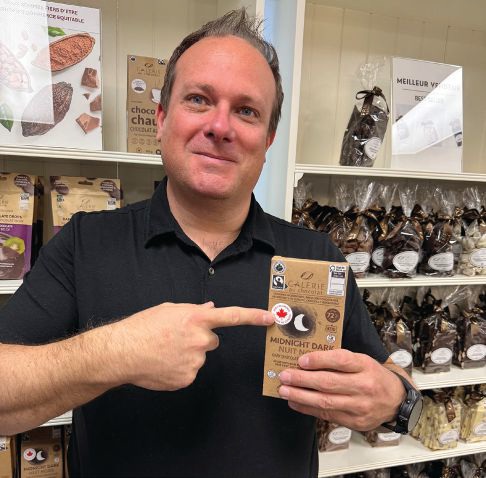 According to Pinsky, the decision to purchase the DGT Solutions’ folding carton system was in large part prompted by the increasing popularity of its Fairtrade line of chocolate bars.
According to Pinsky, the decision to purchase the DGT Solutions’ folding carton system was in large part prompted by the increasing popularity of its Fairtrade line of chocolate bars.
“This line has the largest growth of all the products that we have, and it was also the product that was the most conducive to automation, because it’s one box,” Pinsky explains.
“The boxes are printed differently, but it’s all the same-sized box, whereby the flow-wrapped chocolate bar that goes into the box, into the master case, and then gets placed on a pallet.
“Conversely, when we do the gift wrapping, it’s very tough to automate them process because it affects the quality,” Pinsky notes.
By automating the packaging line for the Fairtrade chocolate bar line, the company was able to significantly improve its efficiency for making these products.
“It reduced our production costs because that line is actually fully automated from production right through to packaging,” Pinsky says. “It increased our output, and it reduced our labor costs.
“So it really helped the efficiency.”
Installed about 12 months ago, the cartoner has already delivered impressive results.
“It’s been amazing,” Pinsky extols. “We’ve been able to quadruple our output and reduce labor by 75 per cent on that line. Before we used to have people taking the box, folding the box, putting the chocolate bar in, closing the box, sealing the box, and putting the date code on,” he relates. “But it has really come a long way since.
“Now, from actually depositing the chocolate into the mould through to the product being on the pallet, I think it’s only touched by a human two times,” says Pinsky.
Reducing human interaction with the products has also reduced the risk of product contamination, he points out.
“There is less chance of hair particles or things like that getting into the product,” Pinsky explains. “Despite wearing uniforms, these things unfortunately can happen.”
In spite of investing heavily in automation over the past 10 years, Galerie au Chocolat has continued to grow its workforce.
“The goal is not to force people to lose their jobs, because that’s the last thing we want,” Pinsky states. “We have people who have been here 30 years.
“But it helps with efficiency, and when people do turn over, they don’t have to be replaced: we can put them elsewhere within the business to help with production,” Pinsky says. “Our goal in investing automation is to increase output and improve efficiency,” he concludes.
“It’s never about cutting jobs.”

